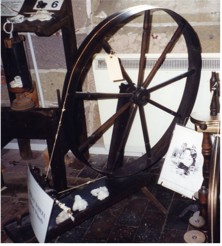 |
The Great Wheel was often used in spinners' cottages to spin yarn for weaving and knitting. The British great wheel was smaller than the American, which accounts for the small size of this wheel. Picture taken at Strutt's North Mill in Belper, Derbyshire by Jenny Freed. |
| The Jersey Wheel was invented between the twelfth and fourteenth centuries. Picture taken at the Tolson Memorial Museum in Huddersfield, Yorkshire by Jenny Freed. |
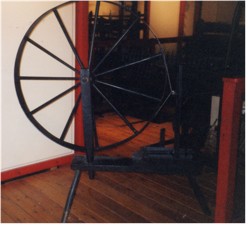 |
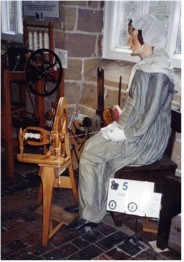 |
The Bobbin and Flyer wheel was fundamentally different from the walking wheels (jersey and great wheel), because it had a foot peddle. Picture taken at Strutt's North Mill in Belper, Derbyshire by Jenny Freed. |
| A front view of James Hargreaves' spinning jenny. It was based on the walking wheel principle of spinning (great wheel). Through a system of drafting and pulling, the slivers were twisted and spun onto bobbins, but the yarn tended to be uneven (had nubs) and of poor quality. Picture taken at Strutt's North Mill in Belper Derbyshire by Jenny Freed. |
 |
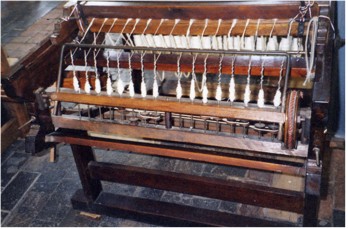 |
A back view of James Hargreaves' spinning jenny. Picture taken at Strutt's North Mill in Belper, Derbyshire by Jenny Freed. |
| A side view of James Hargreaves' spinning jenny. The jenny was operated manually and required the worker to bend over the machine; it was back-breaking work and highly uncomfortable. Picture taken at Strutt's North Mill in Belper, Derbyshire by Jenny Freed. |
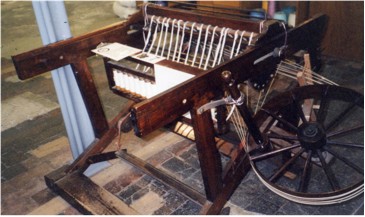 |
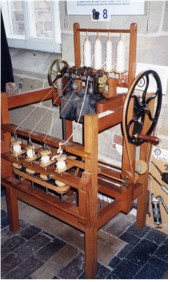 |
A hand-crank model of Richard Arkwright's water-frame. It is meant to show visitors to the museum how the water-frame worked. The real water-frames were powered by water-wheels or steam engines. Picture taken at Strutt's North Mill in Belper, Derbyshire by Jenny Freed. |
| Richard Arkwright's water-frame. The weights (square objects on the bottom of the picture) helped produce an even thread, an improvement from the jenny. Picture taken at Strutt's North Mill in Belper, Derbyshire by Jenny Freed. |
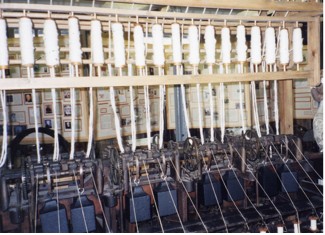 |
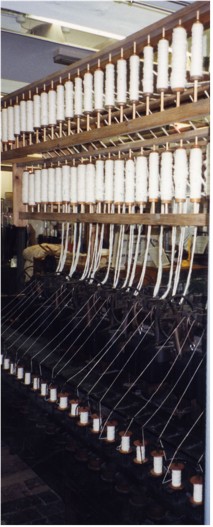 |
A side-view of Arkwright's water-frame. Picture taken at Strutt's North Mill in Belper, Derbyshire by Jenny Freed. |
| A front view of Samuel Crompton's muslin wheel or mule. If you look at the above images of the jenny and water-frame, you will see the mule is a combination of the other two machines. Also, the yarn was wound directly onto pirns and therefore could be put directly onto shuttles and used immediately for weaving. Picture taken at Strutt's North Mill in Belper, Derbyshire by Jenny Freed. |
 |
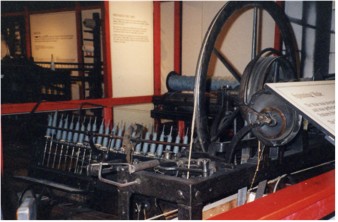 |
Samuel Crompton's muslin wheel or mule. Picture taken at the Tolson Memorial Museum in Huddersfield, Yorkshire by Jenny Freed. |
| A two hundred year old stocking-frame with framework-knitter. Picture taken at Strutt's North Mill in Belper, Derbyshire by Jenny Freed. |
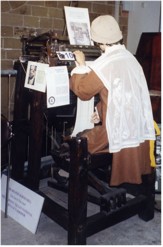 |
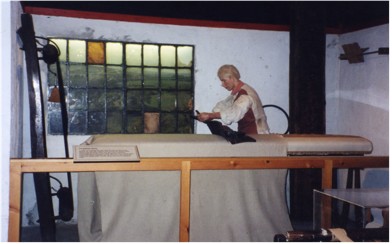 |
A recreation of a cropper at work shearing the nap off the woolen cloth with forty pound shears. On the far left is a nelly, a device used to raise the nap. Picture taken at the Tolson Memorial Museum in Huddersfield, Yorkshire by Jenny Freed. |
| A close-up of cropper at work. Picture taken at the Tolson Memorial Museum in Huddersfield, Yorkshire by Jenny Freed. |
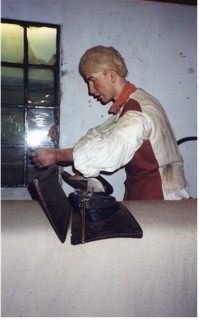 |
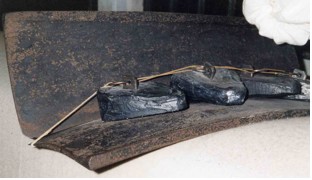 |
A close-up of the weights attached to the cropper's shears. Picture taken at the Tolson Memorial Museum in Huddersfield, Yorkshire by Jenny Freed. |
| A model of the shearing-frame, a machine smashed by croppers during the Luddite Rebellion. It was a fairly recent invention at the time. Picture taken at the Tolson Memorial Museum in Huddersfield, Yorkshire by Jenny Freed. |
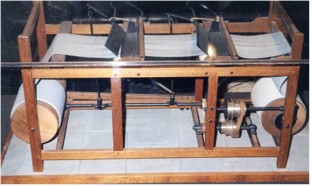 |
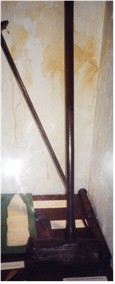 |
The famous hammer ("Enoch") used by the croppers to smash machinery during the Luddite Rebellion. Picture taken at the Tolson Memorial Museum in Huddersfield, Yorkshire by Jenny Freed. |
| Carding Engine, used to prepare fiber for spinning. Picture taken at Strutt's North Mill in Belper, Derbyshire by Jenny Freed. |
 |

















